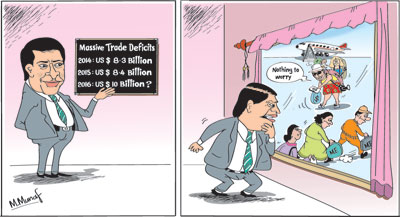Columns
A massive trade deficit in 2016, yet a current account surplus in BOP
View(s):The trade deficit in 2016 is estimated to be a massive US$ 10 billion. However the current account in the balance of payments is likely to be in surplus as worker remittances, earnings from tourism and other services would more than offset this trade gap. Furthermore, to achieve a current account surplus net current income out flows for the year would have to be moderate.
 The trade deficit expanding each successive year is symptomatic of fundamental weaknesses in the economy. Disregarding fundamental weaknesses in the country’s trade balance owing to the current account surplus would be imprudent and hazardous.
The trade deficit expanding each successive year is symptomatic of fundamental weaknesses in the economy. Disregarding fundamental weaknesses in the country’s trade balance owing to the current account surplus would be imprudent and hazardous.
Fundamental weaknesses
The trade deficit is likely to reach a new peak of more than US$ 9 billion that is higher than the large trade deficits of the two previous years. The trade deficit of US$ 8.3 billion in 2014 was surpassed in 2015 to reach US$ 8.4 billion. In the first ten months of 2016 alone, the trade deficit reached US$ 8.2 billion and is likely to edge towards US$ 10 billion in 2016.
The expanding trade deficit each successive year is a serious flaw in the economy. For some years exports have been only a little above 50 percent of import expenditure. In the first ten months of last year exports were only 42 percent of import expenditure in spite of only a slight increase in imports. This is a serious imbalance in the country’s trade that has to be remedied by an expansion of exports.
Mind the gap
The current account surplus should not blind us to this fundamental weakness in our external trade of imports being considerably higher than our export earnings. Import expenditure was more than twice the export earnings in the first ten months of last year. It was 2.4 times the export earnings despite import expenditure declining slightly. This shows clearly the inadequate performance of exports that declined last year too.
This has been a fundamental economic weakness for many years. The country has been incurring trade deficits since 1978. In fact since 1950 there have been trade surpluses in only five years. In recent years export earnings were only around 55 percent of import expenditure. In spite of imports declining in the first ten months of 2016, the proportion of exports to imports declined to 42 percent.
 Exports
Exports
In the first ten months of 2016, total exports declined by 2.6 percent from US$ 8,852 million in the first ten months of 2015 to US$ 8,618 million in the corresponding period in 2016. Both agricultural and industrial exports decreased from last year’s poor performance.
Agricultural exports decreased by as much as 7.1 percent mainly due to decreased tea export earnings by 6.1 percent. Depressed global demand for tea from oil exporting countries was mainly responsible for this decrease. There were decreased export earnings from spices and minor agricultural crops too.
Industrial exports too declined in the first ten months by 1.2 percent. The only silver lining is that textile and garments exports expanded by 2.3 percent in the ten months of last year. The restoration of the GSP Plus status, it is hoped, would enhance export possibilities. On the other hand, global economic uncertainty especially owing to US policies is a serious concern for exports in 2017.
Agricultural exports
The poor trade performance has been mainly due to the unsatisfactory export performance. Admittedly the country’s exports face an inhospitable global market. This was particularly so with respect to tea exports as our main export markets in Russia and West Asia faced depressed incomes owing to the fall in oil prices. Exportable surpluses too have been decreasing in traditional export crops. Export quantities of non-traditional agricultural exports have not increased adequately to make a significant impact on export earnings. In fact export earnings from spices and other agricultural crops declined.
Imports
Import expenditure that was rising in 2014 and 2015 was contained after the adoption of a more realistic exchange rate policy and monetary and fiscal measures that reined in imports. Both consumer and investment goods imports have declined slightly. However, investment goods imports that include transport equipment and machinery have increased.
In the first ten months of last year investment goods imports increased by 13.2 percent, while consumer goods imports decreased by 9.2 percent and intermediate goods imports too decreased slightly by 1.3 percent. Although expenditure on imports at US$ 15,852 million during the first ten months of 2016 increased only marginally by 0.2 per cent, it was nearly twice export incomes. Therein lies the fundamental weaknesses in the trade balance.
BOP surplus
Despite the large trade deficit in 2016, the current account of the balance of payments is likely to be in surplus owing to remittances, earnings from tourism and other receipts for services that would exceed the trade deficit. Therefore, the current account of the balance payments is likely to achieve a surplus of around US$ 2 billion. The overall balance of payments is also likely to be in surplus by a small amount.
The current account of the balance of payments is likely to be in surplus as workers remittances and earnings from tourism would exceed the trade deficit of US$ 9 billion. Workers’ remittances and earnings from tourism exceed the trade deficit of the first ten months of 2016. Earnings from tourism are estimated to have increased by 14 percent to around US$ 3.4 billion during 2016, while workers’ remittances increased by 3.7 percent to US dollars 7.2 billion during the year. These together amount to US$ 10.6 billion.These figures as a table or chart.
In conclusion
The inadequate export performance has been over a long period of time due to inherent weaknesses in the economy that has constrained export diversification and in developing a comparative advantage in exports. Imports, being nearly double the country’s export earnings, are a serious weakness in the country’s external finances. The trade gap must be reduced to about US$ 7 billion to improve the foreign reserve position of the highly indebted economy. Being complacent of the burgeoning trade deficit because it is offset by remittances and earnings from tourism would be a serious flaw in economic policies.


Leave a Reply
Post Comment